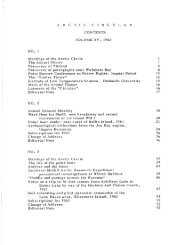Volume 4, 1951 - The Arctic Circle - Home
Volume 4, 1951 - The Arctic Circle - Home
Volume 4, 1951 - The Arctic Circle - Home
Create successful ePaper yourself
Turn your PDF publications into a flip-book with our unique Google optimized e-Paper software.
<strong>The</strong> third flight, on November l, followed the same<br />
route to Resolute Bay except that the turning point was<br />
farther north, off the mouth of Ommanney Bay. From Resolute<br />
we flew straight back to Churchill. Cloud distribution and<br />
flight track were however sufficiently different to avoid a<br />
monotonous repetition of the observations of the previous<br />
flight. King VJîlliam Island was again mostly obscured but<br />
we had a good view of the north coast, just west of Cape<br />
Felix. At this time the coastline, which is flat and<br />
featureless, was quite easily visible, and so was the tide<br />
crack between the smooth fast ice and the pack. It was not<br />
hard to believe, hovlever, that later in the year, when there<br />
is more snow, the coast itself might be very hard to distinguish<br />
and the ice-edge be taken for the coastline. This is<br />
of course a well-known difficulty with low-lying arctic<br />
coastlines in vJinter and is responsible. for many of the inaccurate<br />
outlines which are only now being removed from the<br />
maps.<br />
<strong>The</strong> southwest coast of Prince of \!ualesIsland is also<br />
low-lying and featureless in outline. On the D.S.A.F.<br />
Aeronautical Chart (1946) it is impossible to identify any<br />
features except Cape Swinburne. <strong>The</strong> new National Topographic<br />
8-mile sheet of the southern part of the island is a very<br />
great improvement. On this map the whole tip of the island<br />
is placed about 35 minutes farther east. This position is<br />
undoubtedly more accurate but it would seem that it still<br />
may not be correct, as it does not tie in with our time of<br />
crossing the coastline on either flight.<br />
<strong>The</strong> icein Ommanney Bay VilaS solid and quite rough<br />
and ridgy. <strong>The</strong> Rawlinson ~;lountainsto the southwest of the<br />
mouth of the bay made a good landmark. Though apparently<br />
not very high they stood out weIl in contrast to the low<br />
land behind them and the sea ice in front. <strong>The</strong> edge of the<br />
bay ice was clearly marked, running in a line from Minto Head<br />
to the Hay Islands. <strong>The</strong> ice immediately to seaward of it was<br />
newer and smoother looking, but farther out there was an<br />
agglomeration of very rough, old-looking floes which must<br />
have been floating around for s8veral seasons. A large lead,<br />
partly open, was seen just before the turning point.<br />
<strong>The</strong> sun was setting as we took off from ResDlute, with<br />
a fine pair of sundogs for company. As we approached Somerset<br />
Island the little round Limestone Island made a very good landmark,<br />
visible from a long way off because of its dark vertical<br />
cliffs and flat snow-covered top, like a cake with frosting on












